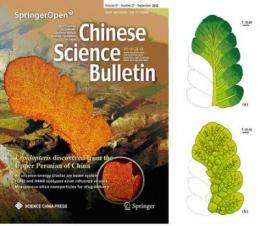The cover of Chinese Science Bulletin (English Edition) 2012, 57(27) (left) and the reconstruction of Lepidopteris baodensis (right), showing the upper surface (a) and the lower surface (b) of an ultimate pinna. Credit: ©Science China Press
Recently, a mysterious seed fern, Lepidopteris baodensis sp. nov., dating to more than 251 million years ago (Ma), was discovered at the Baijiagou of Baode, Shanxi, China, from the Upper Permian Sunjiagou Formation. This discovery completely changed the understanding of the stratigraphic distribution of the genus Lepidopteris in China and promoted the taxonomic study of late Paleozoic plants.
Since Schimper erected the genus Lepidopteris in 1869, its epidermal structure of subepidermal swellings (formerly called "blisters") had long been an unsolved mystery. Excitingly, we found subepidermal swellings not only on the lower surfaces of the ultimate rachis and midrib, but also on the lower surfaces of secondary veins. In addition, the unique epidermal structures of subepidermal swellings on the ultimate rachis, midrib and secondary veins were revealed. The epidermis of a subepidermal swelling on an ultimate rachis was composed of ordinary epidermal cells and stomatal apparatuses forming longitudinal rows and numerous groups. The epidermal cells and stomatal apparatuses in each group were set in a concentric pattern. The epidermis of a subepidermal swelling on the midrib was also composed of ordinary epidermal cells and stomatal apparatuses that formed only 3 groups, and were set in a concentric pattern. The epidermis of a subepidermal swelling on a secondary vein was composed of ordinary epidermal cells and stomatal apparatuses, forming a concentric pattern. Because, unlike the lower surface, the upper surface lacked subepidermal swellings, the difference in epidermal structures between the upper and lower surfaces is remarkable. This situation is very rare in plants.
This research was carried out by Dr. Zhang Yi, Associate Professor at the College of Paleontology, Shenyang Normal University, Mr. Zheng Shaolin, Adjunct Professor at the College of Paleontology, Shenyang Normal University, and Dr. Naugolnykh, Professor at the Geological Institute, Russian Academy of Sciences. This article was published as a cover article on Chinese Science Bulletin (Chinese Edition) 2012, 57(24) and Chinese Science Bulletin (English Edition) 2012, 57(27).
In 2004, the noted paleontologists and biostratigraphers Rong Jiayu (Academician Professor of NIGPAS) and Fang Zongjie (Professor of NIGPAS) pointed out in the book "Mass Extinction and Recovery" that the Earth experienced a mass extinction and recovery between the Late Permian and the Triassic, traced back to 260 Ma. The climate became extremely hot and arid at the end of the Permian. The mass extinction, which was the largest in Earth's history, destroyed most terrestrial and marine ecosystems. On land, coal-forming floras, represented by Lepidodendron and Cordaites, went extinct. The Euramerican, Cathaysian, Gondwanan and Angaran floras disappeared, and a new flora, represented by Pleuromeia, flourished after the disaster. The recovery of coal-forming floras on a large scale did not begin until the Late Triassic.
Although the terrestrial and marine ecosystems of the Earth experienced their largest mass extinction in the Late Permian, the seed fern Lepidopteris became an important element of remnant vegetation and persisted through the Triassic. Thus, the study of Lepidopteris plays a very important role in understanding this mass extinction and recovery.
Which adaptations allowed Lepidopteris to survive the harsh environment? The authors believe its persistence was probably related to the subepidermal swellings, which were special tissues unique to Lepidopteris. Based on analysis of the cuticle, the lower surfaces of the ultimate rachis, midrib and secondary veins, which are related to conducting tissues, were covered with subepidermal swellings. These subepidermal swellings were probably small water storage features that absorbed water during high flows in conducting tissues and released it during low flows, like an irrigation system. In this way, Lepidopteris, a seed fern that originally needed much water to live, probably survived the hot and arid environment. Of course, subepidermal swellings are likely to have had other functions as well.
Although Lepidopteris was a typical element of the Late Permian Euramerican flora, the species L. ottonis was considered to be an index fossil for the Upper Triassic in China. As a result, the stratigraphic distribution of this very important genus in the Upper Permian of China was long neglected. The new species L. baodensis not only expands our knowledge of the biology and taxonomy of Lepidopteris and the stratigraphy of the Upper Permian of China, but also provides an opportunity to understand the relationship between Euramerican and Cathaysian floras in a paleoclimatic, paleoenvironmental and paleogeographic context.
The experimental works were accomplished in the newly established laboratory of the College of Paleontology, Shenyang Normal University, Liaoning Province, China. Specimens are housed at the College of Paleontology, Shenyang Normal University. The Baijiagou of Baode, Shanxi, China, the locality where Lepidopteris baodensis was discovered, has become an area of intense research for Chinese and foreign geologists.
More information: csb.scichina.com:8080/Jwk_kxtb … volumn/current.shtml
Journal information: Chinese Science Bulletin
Provided by Science in China Press





















